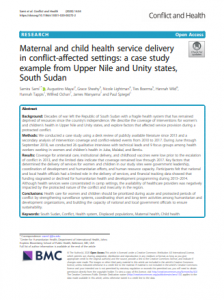
Background
Decades of war left the Republic of South Sudan with a fragile health system that has remained deprived of resources since the country’s independence. We describe the coverage of interventions for women’s and children’s health in Upper Nile and Unity states, and explore factors that affected service provision during a protracted conflict.
Methods
We conducted a case study using a desk review of publicly available literature since 2013 and a secondary analysis of intervention coverage and conflict-related events from 2010 to 2017. During June through September 2018, we conducted 26 qualitative interviews with technical leads and 9 focus groups among health workers working in women and children’s health in Juba, Malakal, and Bentiu.
Results
Coverage for antenatal care, institutional delivery, and childhood vaccines were low prior to the escalation of conflict in 2013, and the limited data indicate that coverage remained low through 2017. Key factors that determined the delivery of services for women and children in our study sites were government leadership, coordination of development and humanitarian efforts, and human resource capacity. Participants felt that national and local health officials had a limited role in the delivery of services, and financial tracking data showed that funding stagnated or declined for humanitarian health and development programming during 2013–2014. Although health services were concentrated in camp settings, the availability of healthcare providers was negatively impacted by the protracted nature of the conflict and insecurity in the region.
Conclusions
Health care for women and children should be prioritized during acute and protracted periods of conflict by strengthening surveillance systems, coordinating short and long term activities among humanitarian and development organizations, and building the capacity of national and local government officials to ensure sustainability